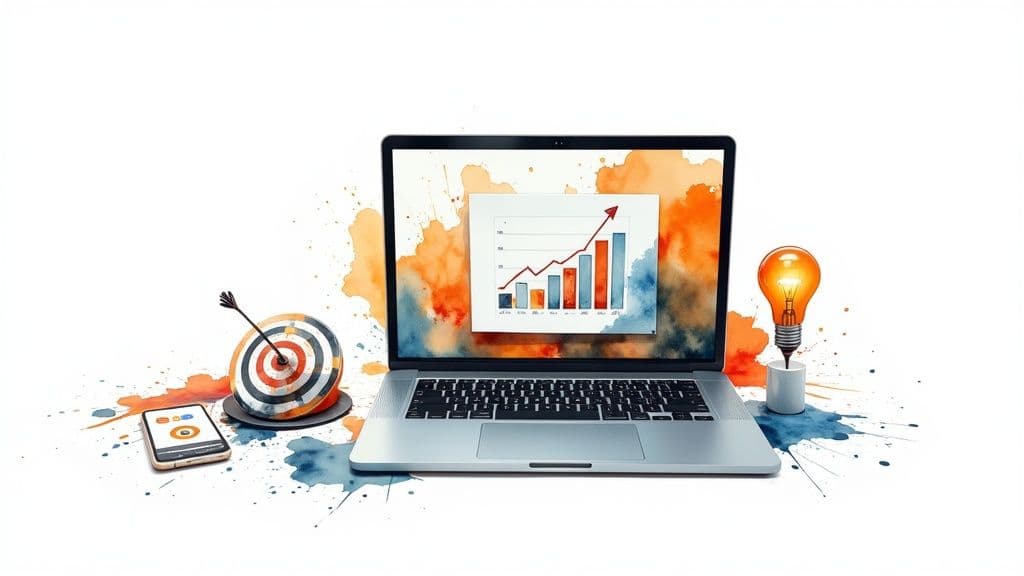
Create a Perfect Bricks Texture Seamless with AI
Learn how to create a flawless bricks texture seamless design using AI. Our friendly guide has actionable tips for realistic, tileable patterns.
Discover the top benefits of digital marketing. Learn how it provides better ROI, precise targeting, and global reach to grow your business effectively.

Instastock Team
October 2, 2025 • 14 min read
In today's hyper-connected world, standing out is tougher than ever. Traditional advertising methods, like print ads or billboards, often feel like shouting into a void; they're expensive and nearly impossible to measure accurately. But what if you could speak directly to your ideal customer, understand exactly what works, and do it all on a budget that makes sense?
That's precisely where the power of digital marketing comes in. It’s not just another channel; it’s a fundamental shift in how businesses connect with people. In this guide, we'll explore the eight most significant benefits of digital marketing, breaking down how each one can deliver tangible, game-changing results for your brand. This isn't just about theory; it’s about practical application. For business owners looking to get a foothold, understanding these principles is the first step. To further understand how digital marketing empowers business owners, this guide on mastering digital marketing as an entrepreneur offers valuable insights.
From laser-focused targeting that puts your message in front of the right people to unbeatable ROI that stretches every pound, you'll discover why embracing a digital-first approach is essential for survival and growth. Let’s dive into the core advantages that will help you compete and win.
One of the most powerful benefits of digital marketing is its incredible efficiency. Gone are the days of spending a fortune on billboard or television ads with no real way to measure their impact. Digital campaigns let you reach a vast, targeted audience without an enormous upfront investment, levelling the playing field for businesses of all sizes.
This approach flips traditional marketing on its head. Instead of committing a large budget and hoping for the best, you can start small, test different strategies, and allocate more funds only to what is proven to work. Every pound is trackable, from the initial click to the final sale. This transparency is a game-changer, allowing you to pinpoint exactly which channels are driving growth.
Key Insight: Digital marketing's true power isn't just about lower costs; it's about financial clarity. Knowing precisely where your money is going and what results it's generating empowers you to make smarter, data-driven decisions that fuel sustainable growth.
To fully grasp this, learning how to calculate marketing ROI is crucial, as it provides the framework for measuring success.
One of the most revolutionary benefits of digital marketing is the ability to speak directly to your ideal customer. Traditional advertising casts a wide, expensive net, hoping to catch the right people. Digital marketing, however, acts like a laser, allowing you to pinpoint specific demographics, interests, and online behaviours with incredible accuracy.
This precision means your marketing budget is spent only on reaching people who are genuinely interested in what you offer. You can tailor your message based on age, location, past purchases, or even life events, making your campaigns profoundly more relevant and effective. This personalised approach not only increases conversion rates but also builds stronger customer relationships.

Key Insight: Effective targeting isn't about excluding people; it's about prioritising them. By focusing your resources on the most qualified prospects, you avoid wasting money and ensure your message resonates deeply, transforming potential interest into loyal custom.
This strategy is the backbone of platforms like Google and Facebook, where advertisers can connect with niche audiences that were previously unreachable.
Traditional marketing often felt like shouting into the void, you’d spend your budget and hope for the best, with little feedback for weeks or months. One of the most transformative benefits of digital marketing is the ability to see exactly what’s happening with your campaigns, as it happens. This real-time feedback loop is an absolute game-changer for businesses of any size.

With powerful tools at your fingertips, you can track user behaviour, monitor conversion paths, and measure performance against your goals instantly. This isn't just about collecting data; it's about gaining immediate insights that allow you to react, adapt, and optimise your strategy on the fly. You can see which ads are resonating and which are falling flat, empowering you to make smart decisions that boost efficiency and drive better results.
Key Insight: The power of real-time analytics isn't just in seeing what happened yesterday; it's in shaping what happens tomorrow. By having instant access to performance data, you can pivot quickly, fix what isn't working, and double down on your successes before wasting a single extra penny.
Traditional marketing has always been constrained by geography. A newspaper ad only reaches people in that city, and a billboard is seen only by those who drive past it. Digital marketing completely shatters these limitations, offering businesses of any size the ability to connect with customers across the globe almost instantly.

Through search engines, social media, and online marketplaces, a small business in Manchester can sell its products to a customer in Melbourne as easily as to someone down the street. This accessibility opens up enormous new markets and growth opportunities that were previously only available to large multinational corporations with deep pockets for international expansion.
Key Insight: The true power of global reach isn't just about selling to more people; it's about market diversification. By accessing international audiences, you reduce your reliance on a single local economy, making your business more resilient and adaptable to market changes.
Traditional marketing was largely a one-way street, where brands broadcasted messages to a passive audience. One of the most transformative benefits of digital marketing is its ability to turn this monologue into a dynamic, two-way conversation. It builds bridges between a brand and its customers, fostering relationships that go far beyond a simple transaction.
Through social media, live chat, and interactive content, businesses can now listen to, respond to, and learn from their audience in real-time. This direct line of communication allows you to provide instant support, gather valuable feedback, and build a genuine community. When customers feel heard and valued, they transform from one-time buyers into loyal brand advocates.
Key Insight: True engagement isn't about just talking at your customers; it's about creating a space where they can talk with and about you. This sense of community and connection is a powerful driver of long-term loyalty and organic growth.
In the fast-moving world of business, agility is everything. One of the most significant benefits of digital marketing is its incredible flexibility, allowing you to adapt your strategy on the fly. Unlike a printed advert or a television commercial that is set in stone once it goes live, digital campaigns can be modified, paused, and optimised instantly in response to performance data and market trends.
This dynamic nature means you are never locked into an underperforming strategy. If an advert isn't resonating with your audience, you can change the creative or copy within minutes. If a particular channel is draining your budget without delivering results, you can reallocate those funds to a more profitable one immediately. This ability to pivot is crucial for staying relevant and maximising your impact.
Key Insight: Digital marketing's flexibility transforms your campaigns from static messages into living, breathing entities. The power to make real-time adjustments ensures your marketing efforts are always aligned with current customer behaviour and business goals, preventing wasted spend and capitalising on emerging opportunities.
This agility is a core reason why businesses are increasingly moving their budgets away from traditional, more rigid forms of advertising.
One of the most transformative benefits of digital marketing is its ability to democratise advertising. No longer is effective marketing the exclusive domain of multinational corporations with nine-figure budgets. Digital channels give small and medium-sized businesses access to the same platforms and sophisticated tools, allowing them to compete directly with industry giants.
With a clever strategy and a focus on creativity, a small brand can outmanoeuvre a larger, slower competitor. Agility is the small business’s superpower. You can test ideas, pivot quickly, and connect with niche audiences in a more authentic way than a corporate behemoth ever could. This creates an environment where the best ideas, not the biggest budgets, can win.
Key Insight: Digital marketing shifts the competitive advantage from financial power to strategic creativity. Small businesses can leverage their unique voice and agility to build deeply loyal communities, a feat that large corporations often struggle to replicate.
In a crowded online world, generic messages get lost in the noise. One of the most significant benefits of digital marketing is the ability to move beyond one-size-fits-all communication and deliver highly personalised experiences. By leveraging customer data, behaviour, and preferences, you can create unique journeys that make each customer feel seen and understood.
This level of customisation transforms your marketing from an interruption into a welcome service. Instead of shouting at a crowd, you're having a one-to-one conversation. From product recommendations that seem to read a customer's mind to email campaigns that address their specific needs, personalisation builds a deeper, more meaningful connection that boosts loyalty and drives conversions.
Key Insight: True personalisation isn't just about using a customer's first name. It's about using data to anticipate their needs and deliver the right message on the right channel at the right time, making their entire experience with your brand seamless and valuable.
This customer-centric approach is no longer a luxury; it's an expectation that separates thriving businesses from those that fail to connect with their audience.
| Aspect | Cost-Effectiveness and Better ROI | Precise Audience Targeting | Real-Time Analytics and Measurability | Global Reach and Accessibility | Enhanced Customer Engagement and Interaction | Flexibility and Real-Time Optimization | Level Playing Field for Small Businesses | Personalization and Customer Experience Enhancement |
|---|---|---|---|---|---|---|---|---|
| Implementation Complexity 🔄 | Moderate: Requires ongoing optimization expertise and learning curve | High: Involves detailed audience segmentation and data handling | High: Needs analytical skills and data interpretation | Moderate: Must adapt to markets, languages, regulations | High: Requires constant monitoring and active interaction | Moderate to High: Needs continuous monitoring and testing | Moderate: Accessible but needs creativity and strategy | High: Complex data infrastructure and privacy compliance |
| Resource Requirements ⚡ | Low to Moderate: Small budgets suffice, but expertise needed | Moderate: Access to detailed data and targeting tools | Moderate to High: Analytical tools and skilled personnel | Moderate: Multi-language and compliance resources needed | Moderate to High: Staffing for monitoring and engagement | Moderate: Monitoring tools and automation platforms required | Low to Moderate: Low spend but needs marketing talent | High: Requires AI tech, data platforms, and automation |
| Expected Outcomes 📊 | High ROI with scalable investment and real-time budget control | High: Improved conversion rates through precise targeting | High: Immediate insights enable rapid optimizations | High: Access to billions globally, expands market reach | High: Increased loyalty, advocacy, and engagement | High: Quick adaptation maximizes campaign efficiency | Moderate to High: Enables competition with bigger players | High: Better satisfaction, loyalty, and conversion rates |
| Ideal Use Cases 💡 | Budget-conscious businesses seeking measurable ROI | Businesses aiming for specific, qualified customer segments | Marketers needing performance data for optimization | Companies targeting international or multicultural audiences | Brands focused on community building and real-time interaction | Campaigns requiring agility and frequent adjustments | Small businesses competing against industry giants | Businesses delivering tailored experiences at scale |
| Key Advantages ⭐ | Lower costs, scalable spend, precise budget control | Eliminates ad waste, enables personalization at scale | Data-driven decisions, continuous improvement | No location limits, cost-effective global expansion | Builds strong relationships, viral potential | Fast responses to trends, risk reduction via testing | Democratizes access to advanced tools and platforms | Higher retention, trust, and personalized user journeys |
As we've explored, the benefits of digital marketing are far more than just abstract concepts. They are tangible, powerful forces that can fundamentally transform your business's trajectory. From the unparalleled cost-effectiveness and ROI we discussed to the granular audience targeting that puts your message in front of the right people, every benefit is a stepping stone towards sustainable growth.
The true power lies in how these elements work together. Real-time analytics aren't just about data; they're about having the agility to pivot your strategy instantly. A global reach isn't just about crossing borders; it’s about levelling the playing field so your small startup can compete with established giants. This interconnected ecosystem is what makes digital marketing so dynamic and essential in today's market.
Feeling inspired but not sure where to begin? Don't let the sheer number of possibilities lead to inaction. The key is to start with focused, measurable steps that align directly with your most pressing business goals.
Here’s a simple framework to get you started:
Ultimately, mastering digital marketing is about more than just learning tools and tactics. It's about adopting a new mindset: one of continuous learning, testing, and adapting. The digital landscape is always evolving, and the strategies that work today might need refining tomorrow.
By embracing this agile approach, you move beyond simply doing marketing to building a resilient, customer-centric, and future-proof business. The journey starts not with a massive budget or an elaborate plan, but with the first step you take today. The immense benefits of digital marketing are within your grasp, ready to be unlocked.
Ready to elevate your digital content and capture your audience's attention? Create stunning, high-quality visuals for your marketing campaigns with Instastock. Explore our vast library of royalty-free images and videos to bring your brand’s story to life.

Learn how to create a flawless bricks texture seamless design using AI. Our friendly guide has actionable tips for realistic, tileable patterns.

Learn to design, customize, and use a unique body outline template with AI. Our guide offers practical tips for artists, designers, and creators.

Discover 7 standout sources for a healthy lifestyle poster. Our guide offers design insights for clinics, schools, and offices to inspire wellbeing.